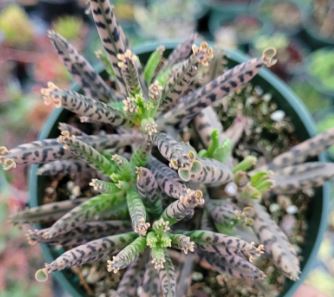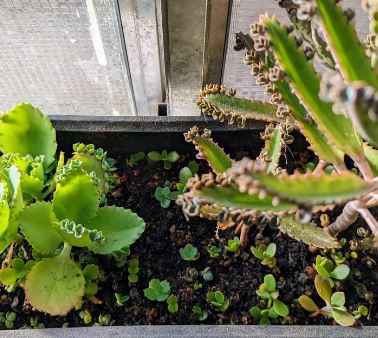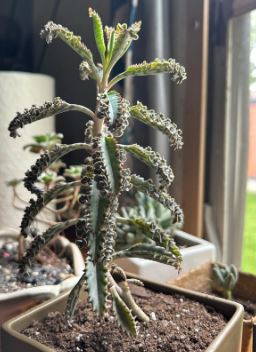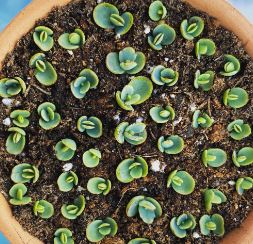Leaf Shape and Size
Mother of Thousands: Broad Leaves, Growing Up to 4 Inches Wide
Kalanchoe daigremontiana, generally known as Mother of Thousands, boasts wide, tear-shaped leaves which could reach an excellent width of 4 inches. These leaves, characterised by means of their robust shape, make a contribution to the plant’s distinct look.
The leaves of Mother of Thousands are not best visually placing but also functionally tremendous. Their broader surface place permits for elevated photosynthesis, helping the plant in thriving in quite a few conditions. This adaptability makes Mother of Thousands a fave among succulent lovers.
Mother of Millions: Narrow, Paddle-fashioned Leaves, Usually Under 2 Inches Wide
On the other hand, Mother of Millions, or Kalanchoe delagoensis, capabilities narrower, paddle-shaped leaves that generally stay underneath 2 inches in width. This variance in leaf form is a vital distinguishing thing between the two succulents.
The slim leaves of Mother of Millions contribute to its standard graceful appearance. While not as expansive as the ones of its counterpart, those leaves serve their reason efficiently, permitting the plant to preserve water and navigate through diverse environmental challenges.
The Significance of Leaf Morphology
Leaf morphology plays a essential role in the version and survival of succulents. The variance in length and form at once impacts the plant’s capability to seize sunlight, modify water loss, and set up its specific aesthetic identification.
In horticulture, enthusiasts often respect the variety in leaf characteristics, the use of them as key identifiers and indicators of the plant’s health and vitality.


Plantlet Formation
Mother of Thousands: Plantlets Along Leaf Margins
Mother of Thousands exhibits a distinct approach of reproduction thru the formation of plantlets along the edges and margins of its leaves. These miniature offshoots, often referred to as “puppies,” function a testomony to the plant’s exquisite capability to proliferate.
The strategic placement of plantlets along the leaf margins gives them with smooth access to soil as soon as detached. This version is not most effective an efficient manner of duplicate but also a survival method, ensuring the propagation of the species in numerous environments.
Mother of Millions: Exclusive Tip Growth
Conversely, Mother of Millions takes a more one of a kind approach to plantlet formation, as these miniature replicas simplest develop at the suggestions of its leaves. This targeted boom pattern adds a layer of intricacy to the reproductive approach of Kalanchoe delagoensis.
The constrained region of plantlets at the hints of leaves indicates a specialised mechanism designed to maximize the probabilities of a success propagation. By concentrating growth in a selected location, Mother of Millions optimizes the deployment of its reproductive resources.
The Evolutionary Advantage of Propagation Strategies
The evolution of distinct propagation strategies in succulents displays the elaborate dance between adaptation and survival. Each species has honed its approach to in shape the environmental demanding situations it faces, making sure the continuation of its genetic lineage.
Propagation mechanisms provide insight into the evolutionary history of succulents, showcasing the resourcefulness and resilience ingrained of their genetic make-up.
Number of Plantlets
Mother of Thousands: Moderate Yield of two-4 Plantlets
Mother of Thousands strikes a stability in its reproductive prowess, producing a slight quantity of plantlets—normally ranging from 2 to four per leaf. This managed output suggestions at a strategy in which excellent is prioritized over amount.
The restrained quantity of plantlets in keeping with leaf permits every offspring to get hold of enough vitamins and sources for its initial boom. This intentional moderation aligns with the plant’s average adaptive method, emphasizing the significance of making sure the achievement of each propagated character.
Mother of Millions: Prolific Reproduction with Over 10 Plantlets
In stark comparison, Mother of Millions lives up to its name by means of showcasing a extra prolific reproductive ability. This succulent species frequently surpasses its counterpart, producing an abundance of plantlets, sometimes exceeding 10 in keeping with leaf.
The abundance of plantlets aligns with a specific ecological approach, emphasizing the sheer volume of offspring to growth the likelihood of a hit establishment in diverse habitats. This prolific technique is a testomony to the adaptability and tenacity of Mother of Millions.
The Ecological Implications of Reproductive Output
The varying reproductive outputs of these succulents communicate to their ecological roles and techniques. Mother of Thousands’ controlled yield shows a nuanced technique to aid allocation, while Mother of Millions’ prolific manufacturing aligns with a broader dispersal method.
Understanding the ecological implications of reproductive output contributes to a comprehensive appreciation of these plant life within their natural ecosystems.


Leaf Margin
Mother of Thousands: Smooth Margins for Enhanced Aesthetics
The leaves of Mother of Thousands feature clean margins, contributing to the general aesthetic attraction of the plant. The absence of serrations or indentations alongside the edges complements the visible uniformity of the succulent.
The clean margins also serve a purposeful purpose, minimizing potential points of water loss via transpiration. This adaptation displays the plant’s efficiency in retaining moisture, an vital trait in arid and semi-arid environments.
Mother of Millions: Wavy or Scalloped Margins for Visual Intricacy
In contrast, Mother of Millions introduces a visual intricacy with leaves which could show off slightly wavy or scalloped margins. This deviation in margin traits adds a layer of complexity to the overall appearance of the plant.
The wavy or scalloped margins now not only contribute to the classy diversity but may additionally serve practical roles, probably helping in water retention or mild capture. This illustrates the interplay among visual enchantment and adaptive capability in succulent evolution.
The Intersection of Form and Function in Leaf Margins
The diversity in leaf margin characteristics showcases the delicate balance among form and function in succulents. While clean margins of Mother of Thousands prioritize simplicity and water conservation, the wavy or scalloped margins of Mother of Millions introduce an detail of visual intrigue.
This intersection of form and characteristic highlights the nuanced variations that succulents rent to thrive in their respective habitats.
Flower Color
Mother of Thousands: Yellow Flowers with Orange Edges
Adding a colourful contact to its repertoire, Mother of Thousands embellishes itself with yellow flora embellished with distinct orange edges. This burst of colour no longer only draws the attention of admirers but additionally serves useful roles inside the plant’s reproductive approach.
The contrasting colours create a visual charm, potentially attracting pollinators and enhancing the chances of successful pollination. This collaboration of aesthetics and characteristic reflects the elaborate dance of nature in succulent ecosystems.
Mother of Millions: Bright Orange Flowers with Yellow Edges
Mother of Millions takes a formidable technique to floral aesthetics, showcasing vibrant orange flora with placing yellow edges. This flamboyant display complements the visual impact of the succulent and serves as a beacon for capacity pollinators.
The specific coloration of the vegetation aligns with the ecological context of the plant’s natural habitat, where those colors may additionally maximize visibility and effectiveness in attracting pollinating agents.
The Role of Floral Coloration in Reproductive Success
Floral shade goes past mere aesthetics, gambling a pivotal position within the reproductive success of succulents. The particular hues and styles are honed thru evolutionary techniques to optimize visibility, entice pollinators, and make certain the continuity of the plant’s genetic lineage.
Understanding the significance of floral colour offers insights into the dynamic interplay between succulents and their pollinators inside their ecosystems.
Growth Habit
Mother of Thousands: Denser, More Compact Clusters
Mother of Thousands adopts a increase addiction characterised via denser, extra compact clusters. This arrangement of individual plants contributes to a cohesive and visually impactful succulent show.
The denser clusters also have useful implications, presenting mutual aid and protection towards environmental stressors. This growth dependancy showcases the adaptability of Mother of Thousands to thrive in a carefully-knit community.
Mother of Millions: Open and Sprawling Growth Tendency
In contrast, Mother of Millions tends to showcase a extra open and sprawling increase habit. The man or woman flora may additionally unfold out, growing a visually dynamic association that covers a bigger vicinity.
This boom tendency aligns with a specific ecological approach, probably permitting Mother of Millions to explore and colonize a broader range of habitats. The open arrangement might also facilitate accelerated publicity to sunlight, a vital factor in succulent boom.
The Ecological Significance of Growth Habits
The various boom behavior observed in succulents contribute to their ecological area of interest specialization. While the denser clusters of Mother of Thousands emphasize mutual support and resource sharing, the open and sprawling increase of Mother of Millions indicates a method of exploration and colonization.
These increase behavior highlight the adaptability of succulents in responding to the particular demanding situations supplied via their environments.
Stems
Mother of Thousands: Thicker and More Pronounced Stems
Mother of Thousands distinguishes itself with thicker and greater pronounced stems. These strong stems provide structural aid to the plant and make a contribution to the general durability of the succulent.
The prominence of stems also complements the visible appeal, growing a balanced and well-defined silhouette. This structural power is specially wonderful within the context of the denser clusters fashioned by Mother of Thousands.
Mother of Millions: Thinner and Less Noticeable Stems
Conversely, Mother of Millions functions thinner and much less great stems. The understated nature of these stems permits the focus to shift toward the foliage and flowers, developing an fashionable and streamlined aesthetic.
The inconspicuous stems do not compromise the plant’s structural integrity but instead contribute to a greater fluid and sleek standard look. This diffused technique aligns with the open and sprawling growth habit of Mother of Millions.
Structural Diversity in Succulents
The diversity in stem traits among succulents illustrates the adaptability of those flora to one of a kind ecological niches. While thicker and extra said stems offer resilience in densely packed clusters, thinner and much less sizeable stems make contributions to a greater streamlined and fashionable presentation.
This structural range is a testament to the flexibility of succulents in adapting to a number of environmental situations.
Cold Tolerance
Mother of Thousands: Surviving Down to 35°F (2°C)
Mother of Thousands famous a commendable bloodless tolerance, with the capacity to continue to exist temperatures as little as 35°F (2°C). This resilience to chillier situations broadens the range of environments where the succulent can thrive.
The bloodless tolerance of Mother of Thousands positions it as a hardy alternative for succulent lovers in regions with cooler climates. This adaptability enhances the plant’s recognition amongst gardeners seeking resilient and low-maintenance additions to their collections.
Mother of Millions: Limited Cold Tolerance, Surviving Down to 45°F (7°C)
In comparison, Mother of Millions showcases a more limited bloodless tolerance, surviving temperatures right down to forty five°F (7°C). While nevertheless resilient, this dilemma shows a preference for milder climates.
The particular temperature threshold displays the evolutionary adaptation of Mother of Millions to its native habitats, where milder conditions are extra time-honored. This bloodless sensitivity influences the choice of suitable cultivation places for this succulent.
Temperature Adaptation Strategies in Succulents
The varying bloodless tolerances found in Mother of Thousands and Mother of Millions underscore the importance of temperature adaptation techniques in succulents. These diversifications are formed by means of the precise environmental situations in their respective native habitats, highlighting the precision with which succulents navigate temperature fluctuations.
Understanding those temperature diversifications is important for effectively cultivating and caring for these remarkable flowers in diverse climates.
Propagation
Mother of Thousands: Ease of Propagation from Leaf Cuttings
Mother of Thousands distinguishes itself with its ease of propagation from leaf cuttings. This straightforward approach allows succulent fans to amplify their collection with minimal effort.
The simplicity of propagating Mother of Thousands from leaf cuttings makes it an accessible choice for both amateur and skilled gardeners. The achievement rate of this method contributes to the popularity of the plant inside the realm of succulent cultivation.
Mother of Millions: Leaf Cutting Propagation with Longer Rooting Times
While Mother of Millions can also be propagated from leaf cuttings, the technique may additionally require greater persistence because of longer rooting times. This function introduces a nuanced aspect to the propagation adventure of Kalanchoe delagoensis.
The extended rooting instances may be attributed to specific physiological or genetic factors inside Mother of Millions. Succulent fans accomplishing propagation sports must be organized for a barely longer ready period for successful root development.
Succulent Propagation: Art and Science
The propagation techniques hired by means of Mother of Thousands and Mother of Millions highlight the art and technological know-how inherent in succulent cultivation. While one gives a short and easy technique, the alternative introduces an element of anticipation and staying power.
Successfully navigating succulent propagation includes a blend of knowledge, revel in, and a deep appreciation for the unique characteristics of each species.
Toxicity
Both Mother of Thousands and Mother of Millions share a commonplace trait—they’re mildly poisonous to both people and animals if ingested. This toxicity is a protection mechanism developed over the years to deter herbivores and potential threats from consuming those succulents.
The mild toxicity, even as no longer extreme, emphasizes the significance of managing these flowers with care, specifically in families with pets or small youngsters. The shared toxic nature additionally indicates a not unusual lineage and evolutionary records between the 2 succulent species.
Bonus Information
Mother of Thousands: The Chandelier Plant
Mother of Thousands is likewise known by using the botanical call Kalanchoe daigremontiana and is going with the aid of the captivating moniker “Chandelier Plant.” This alternative call provides a touch of elegance to the succulent’s identification, reflecting its swish and cascading boom habit.
The nickname “Chandelier Plant” resonates with the visual appeal of Mother of Thousands, evoking pictures of a botanical masterpiece suspended in natural splendor.
Mother of Millions: Lavender Scallops
On the other hand, Mother of Millions consists of the alternative name Kalanchoe delagoensis, accompanied by means of the whimsical alias “Lavender Scallops.” This change designation provides a poetic touch to the succulent’s identity, invoking pics of delicate lavender-hued leaves with scalloped margins.
The name “Lavender Scallops” captures the essence of Mother of Millions, emphasizing its visual intricacy and the subtle splendor found inside the details of its foliage.

Conclusion
In end, the Mother of Thousands and Mother of Millions present succulent fanatics with a fascinating journey into the arena of Kalanchoe. From the nuances in leaf morphology to the intricacies of propagation and ecological adaptations, each component contributes to the rich tapestry of those fantastic flowers.
Understanding the distinctions between Mother of Thousands and Mother of Millions goes beyond mere botanical interest—it gives treasured insights into the resilience, adaptability, and evolutionary techniques of succulents. As guardians of those fascinating plant life, fanatics are higher geared up to foster their nicely-being, making sure thriving, colourful presentations in gardens and collections.
